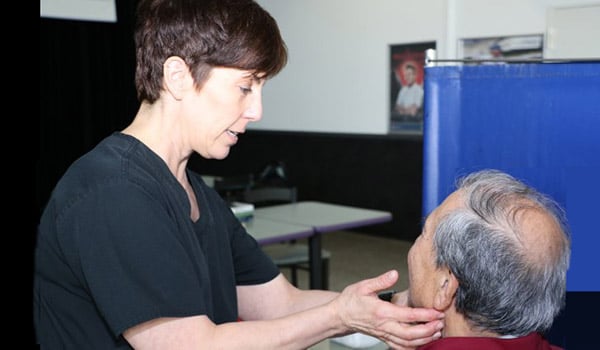
Ask the Flight Surgeon / By CPT Peter Petrillo, P.A.: Q: My neck and upper back have been bothering me for a while and now I’ve started to notice pins and needles in my hand. Are these related?
PA: We live in a world that encourages sitting for long periods of time; at desks, in front of computer screens, at staff meetings, cramped cockpits, etc. Such conditions encourage poor postures with head forward, shoulders slumped and hands rotated in. This routine results in tightening of the muscles in the chest and front of the neck and weakens the opposing muscles in the shoulder blades and the back of the neck.

Photo:army.mil
Hand symptoms such as numbness, tingling, “pins and needles” or weakness can have several causes that warrant further medical evaluation. Of all the potential causes, the compression of a nerve or nerves somewhere between the neck and hand is the most common. When this compression occurs at the wrist it is called carpal tunnel syndrome; at the elbow it is called cubital tunnel syndrome. Pilots are at a higher risk for two additional nerve compression concerns: the first is at the neck as nerves exit the cervical spine through relatively narrow boney passages, and second is at a chokepoint within the chest wall where groups of nerves and vessels combine to exit the chest, or thorax, on the way to the arm.
The human head weighs about twelve pounds and your cervical spine is well designed to handle that weight without difficulty, if you balance the load by maintaining an upright posture. For every inch forward of neutral that you carry your head, your neck will feel an additional ten pound increase in strain. The donning of a flight helmet, ALSE equipment, night vision goggles, batteries and counterweights increases that strain significantly. In addition, most aircrew seats are not recessed for the NVG battery pack that promotes a forward head position while in flight. Aircraft vibration can create a vicious cycle of fatigue that worsens posture to create even more fatigue.
These conditions may adversely affect aircrew safety in a few ways. Neck or shoulder pain can be a significant distraction from flight crew duties. Numbness or weakness of a hand can impair the ability to locate and directly operate flight and optic controls or even hamper safe egress.
Degenerative Joint Disease
Flight conditions and postures (along with your genetics) may lead to a wearing down of the cartilage and remodeling of the bone in the cervical spine. Also known as osteoarthritis, these boney changes may narrow the spaces that exist between vertebrae, “pinching” the nerves as they pass through. This can lead to hand numbness, tingling or weakness. The hand symptoms can vary with neck position and are usually associated with neck or shoulder pain. With time, muscles associated with the pinched nerves may lose mass and become noticeably smaller. Military aircrew may be at increased risk of developing degenerative joint disease of the neck as their number of flight hours increases.
Thoracic Outlet Syndrome
Thoracic outlet syndrome is a condition that can cause hand symptoms like those seen in degenerative joint disease. Here, nerves are compressed by bone or muscle as they pass under the collar bone and beneath the chest muscles. Poor posture is the chief cause, but work or sports that involve frequent overhead arm activities may also be involved. As in degenerative joint disease, weakness and noticeable shrinking of the muscles of the hand may occur over time.
What Next?
If you have symptoms of hand numbness, tingling or weakness, with or without neck or shoulder pain, it is important that you see your flight provider right away. Nerve tissue is sensitive to pressure and the sooner you are diagnosed and treated the less likely that any of your symptoms will become permanent. It is often possible to tease out the origin of the problem by the history of symptoms and physical examination alone. However, further exams to include X-ray, MRI and nerve conduction testing may be necessary to confirm the diagnosis.
Physical therapy is the first line of treatment and will include strategic stretching and strengthening of muscles to encourage good posture.In more severe cases, surgery may be indicated to prevent permanent damage or alleviate symptoms. Most surgical procedures are eligible for flight duty waivers and should be discussed with your flight surgeon before you proceed.
How Can I Reduce My Risk?
An ounce of prevention is worth a pound of cure, so pay attention to your posture during your day and while performing flight duties. Have your physical therapist or flight provider show you some stretches and exercises that can help to discourage poor posture. A strong, supple neck and upright posture is your best defense against these conditions. Of course, just like any other physical or mental issues you might experience, you should talk with your flight provider because it is always better (and safer!) to treat earlier in the process.
Fly safe!
Peter M. Petrillo is an aeromedical physician assistant with the Arizona National Guard and a third year medical student at the Arizona College of Osteopathic Medicine.










